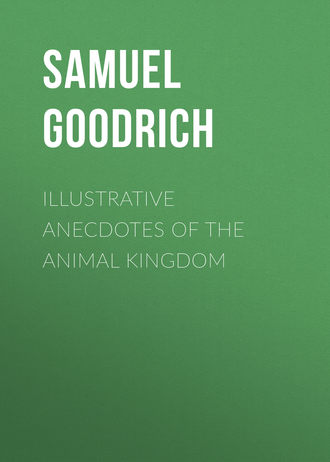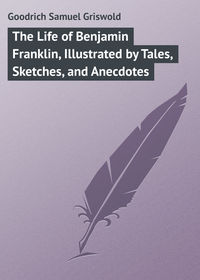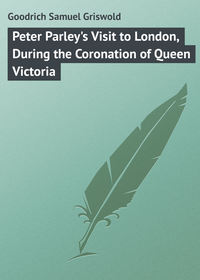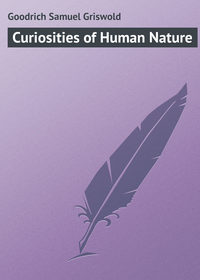 полная версия
полная версияIllustrative Anecdotes of the Animal Kingdom
Two ants meeting on a path across a gravel-walk, one going to and the other from the nest, stop, touch each other's antennæ, and appear to hold a conversation. One would almost fancy that one was communicating to the other the best place for foraging.
THE CATERPILLAR
A curious species of manufacture was contrived by an officer of engineers residing at Munich. It consisted of lace veils, with open patterns on them, made entirely by caterpillars. Having made a paste of the leaves of the plant on which the insect feeds, he spread it thinly over a stone, or other flat substance, of the required size. He then, with a camel's hair pencil dipped in olive oil, drew a pattern he wished the insects to leave open. This stone was then placed in an inclined position, and a number of caterpillars were placed at the bottom. A peculiar species was chosen, which spins a strong web, and the animals commenced at the bottom, eating and spinning their way up to the top, carefully avoiding every part touched by the oil, but devouring every other part of the paste. The extreme lightness of these veils, combined with their strength, is surprising.
THE BUTTERFLY
In June, 1826, a column of butterflies, from ten to fifteen feet broad, was seen to pass over Neufchatel, in Switzerland; the passage lasted upwards of two hours, without any interruption, from the moment when the insects were observed.
THE MOTH
A moth was once caught, at Arracan, which measured ten inches from the tip of one wing to the tip of the other, both being variegated with the brightest colors.
THE SILKWORM
The great care bestowed upon this creature in China is shown in the following extract from an old work: "The place where their habitation is built must be retired, free from noisome smells, cattle, and all noises; as a noisome smell, or the least fright, makes great impressions upon so tender a breed; even the barking of dogs, and the crowing of cocks are capable of putting them in disorder when they are newly hatched. For the purpose of paying them every attention, an affectionate mother is provided for their wants; she is called Isan-more, mother of the worms. She takes possession of the chamber, but not till she has washed herself, and put on clean clothes which have not the least ill smell; she must not have eaten any thing before, or have handled any wild succory, the smell of which is very prejudicial; she must be clothed in a plain habit without any lining, that she may be more sensible of the warmth of the place, and accordingly increase or lessen the fire; but she must carefully avoid making a smoke, or raising a dust, which would be very offensive to these tender creatures, which must be carefully tended before the first time of casting their slough."
During the first twenty-four hours of the silkworm's existence, the patient Chinese feeds the objects of her care forty-eight times a day; during the second or third day, thirty times; and so on, reducing the number of meals as the worm grows older.
FLIES
Sir Arthur Young thus speaks of flies in his "Travels through the South of Europe: " "Flies form the most disagreeable circumstance in the southern climates. They are the first torments in Spain, Italy, and the olive districts of France. It is not that they bite, sting, or hurt; but they buzz, tease, and worry: your mouth, eyes, ears, and nose, are full of them; they swarm on every eatable. Fruit, sugar, milk, every thing, is attacked by them in such myriads, that if they were not driven away, by a person who has nothing else to do, to eat a meal is impossible. If I farmed in these countries, I think I should manure four or five acres of land a year with dead flies."
CLASS RADIATA … RADIATED ANIMALS
This class embraces those beings which are the lowest in the animal kingdom – those which have the fewest and most imperfect senses. Indeed, some of them so far resemble plants as to make the point of separation between the animal and vegetable kingdoms almost a matter of uncertainty. They are called radiata, because in most of them an arrangement may be traced, in their formation, like that of rays branching out from a centre. Among the creatures of this class are the star-fish, polypus, sea-anemone, and infusoria.
POLYPI
Captain Basil Hall makes some interesting remarks on the examination of a coral-reef, which is the product of the marine polypi. He observes that, during the different stages of the tide, the changes it undergoes are truly surprising. When the tide has left it for some time, it becomes dry, and appears to be a compact rock, exceedingly hard and rugged; but as the tide rises, and the waves begin to wash over it, the coral worms protrude themselves from holes which before were invisible. These animals are of a great variety of shapes and size, and in such prodigious numbers, that, in a short time, the whole surface of the rock appears to be alive and in motion. The most common worm is in the shape of a star, with arms from four to six inches long, which move in every direction to catch food. Others are so sluggish that they may be taken for pieces of rock, and are of a dark color; others are of a blue or yellow color; while some resemble a lobster in shape.
The Green Polype, or hydra, is found in clear waters, and may generally be seen in great plenty in small ditches and trenches of fields, especially in the months of April and May. It affixes itself to the under parts of leaves, and to the stalks of such vegetables as happen to grow immersed in the same water. The animal consists of a long, tubular body, the head of which is furnished with eight, and sometimes ten long arms, or tentacula, that surround the mouth.
It is of an extremely predacious nature, and feeds on the various species of small worms, and other water animals, that happen to approach. When any animal of this kind passes near the polype, it suddenly catches it with its arms, and, dragging it to its mouth, swallows it by degrees, much in the same manner as a snake swallows a frog. Two of them may sometimes be seen in the act of seizing the same worm at different ends, and dragging it in opposite directions with great force.
When the mouths of both are thus joined together upon one common prey, the largest polype gapes and swallows his antagonist; but, what is more wonderful, the animal thus swallowed seems to be rather a gainer by the misfortune. After it has lain in the conqueror's body for about an hour, it issues unhurt, and often in possession of the prey that had been the original cause of contention. The remains of the animals on which the polype feeds are evacuated at the mouth the only opening in the body. It is capable of swallowing a worm of thrice its own size: this circumstance, though it may appear incredible, is easily understood, when we consider that the body of the polype is extremely extensile, and is dilated, on such occasions, to a surprising degree.
This species are multiplied, for the most part, by a process resembling vegetation – one or two, or even more young ones emerging gradually from the sides of the parent animal; and these young are frequently again prolific before they drop off; so that it is no uncommon thing to see two or three generations at once on the same polype.







